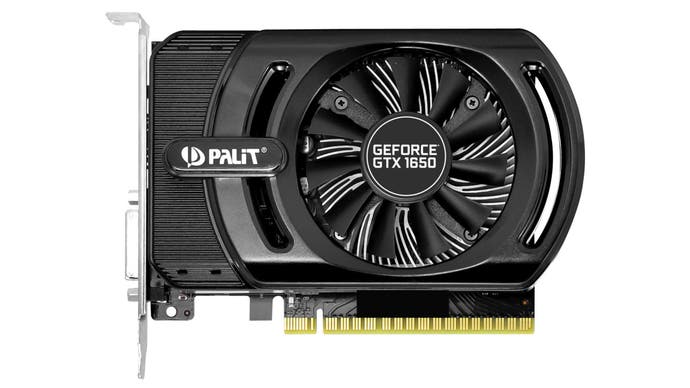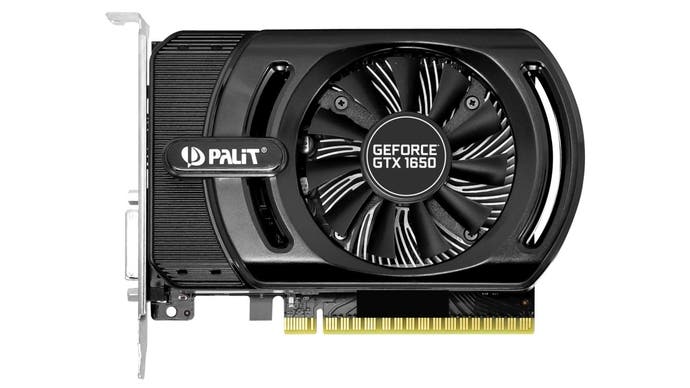Nvidia GeForce GTX 1650 benchmarks: chronic underperformer
Nvidia's smallest 16-series card tested against its closest rivals.
The GTX 1650 completes Nvidia's initial trio of GTX 16-series graphics cards, at a lower price than the GTX 1660 Ti and GTX 1660. The result is an inexpensive card that can still deliver good performance at 1080p, although it struggles at higher resolutions. The GTX 1650 is also a power-efficient card, meaning Nvidia's partners can create compact custom designs with slim coolers that occupy only one or two slots and don't require extra PCI-e power. For builds with limited space and a weak PSU, like prebuilt desktops designed for office use, the GTX 1650 can be a major drop-in upgrade for only £140/$150.
The one fly in the ointment is the existence of a competing card, which is capable of significantly better performance in most games while costing the same price or less. This is the £125/$130 AMD Radeon RX 570, an older GPU that has seen considerable price drops over recent months. In this article, we'll see exactly how big of a performance differential there is between the two cards, as we test nine recent games at 1080p and 1440p resolutions. We have also included the £130/$170 GTX 1050 Ti and the £180/$210 GTX 1060 6GB, two other potential competitors.
Before we get into the numbers, it's worth considering the GTX 1650's feature set too. The card doesn't support hardware-accelerated ray tracing or deep learning super sampling like its RTX brothers and sisters, but it does pack support for other Turing features like variable rate shading (VRS), which should make it a little more future-proof than the last-gen GTX 1050 Ti.
If you want to get a better idea of the decisions Nvidia made to differentiate the GTX 1650 from the GTX 1660 and the last-gen GTX 1060, take a look at the specifications below. We're looking at fewer CUDA cores, only 4GB of VRAM and a paltry 128-bit memory bus; cuts across the board.

| GTX 1650 | GTX 1060 | GTX 1660 | RX 570 | RX 580 | |
|---|---|---|---|---|---|
| GPU cores | 896 | 1280 | 1408 | 2048 | 2304 |
| VRAM | 4GB GDDR5 | 6GB GDDR5 | 6GB GDDR5 | 4GB GDDR5 | 8GB GDDR5 |
| Memory Bus | 128-bit | 192-bit | 192-bit | 256-bit | 256-bit |
| Bandwidth | 128GB/s | 192GB/s | 192GB/s | 224GB/s | 256GB/s |
| Boost Clock | 1665MHz | 1708MHz | 1785MHz | 1244MHz | 1340MHz |
| Processor | TU117 | GP106 | TU116 | Polaris 20 | Polaris 20 |
Our test results are shown below for each of the games and resolutions we benchmarked. We've chosen some interesting comparisons by default, but you can use the controls to the right of each video to choose your own data points too. Press play on the video, and you'll see how each card handles the test scene as it plays out. If you prefer a single glanceable summary, we have more traditional bar charts as well - and this is all you'll get on mobile. If you're on a desktop, these bar charts gain some extra features - you can mouse over to see each card's worst, best and average performance, and you can click on the chart to swap between frame-rate numbers and percentages. Now let's see some results!
Assassin's Creed Odyssey
Assassin's Creed Odyssey is a difficult game to run, thanks to its complex open world and richly detailed landscape. The game is particularly CPU intensive for a modern title, which typically helps Nvidia cards pull ahead of their AMD counterparts at 1080p thanks to a more efficient driver. Even this strong scenario, the GTX 1650 is two percentage points behind the RX 570 at 1080p. At 1440p, the RX 570 is able to pull out to a small four per cent lead.
AC Odyssey: Ultra High
Assassin's Creed Unity
Assassin's Creed Unity is another game that the RX series struggles with, thanks to the depth of field effect used liberally in our test scene (and the game as a whole). Generally we see AMD cards have an unusually wide range of frame-rates, dropping low when the effect is used and shooting back up when the effect is muted. Despite these challenges, the RX 570 still strides to a heavy victory over the GTX 1650, with a 14 per cent advantage at 1080p and a 15 per cent lead at 1440p.
AC Unity: Ultra High, FXAA
Battlefield 1
Battlefield 1 offers something of a worse case scenario for the GTX 1650 against the RX 570, as this DirectX 12 test heavily favours AMD. We can see that the RX 570 comes within striking distance of the significantly more expensive GTX 1060 here, something it doesn't manage in most other games. That also means that the RX 570 far outstrips the GTX 1650, with a 33 per cent lead at 1080p and 1440p. The GTX 1650 still produces playable results at both resolutions we tested, it's not a great result regardless. This is particularly true if we also consider Battlefield 5, which shows a similar AMD/Nvidia dynamic and requires significantly more horsepower.
Battlefield 1: Ultra, TAA
Crysis 3
Crysis 3 is the oldest benchmark we still use, and for good reason: this game is an absolute beast. The frantic sequence we've chosen to benchmark stresses the GPU heavily, allowing us to show the difference between our four cards clearly. At 1080p the GTX 1650 is a confident 15 per cent faster than the GTX 1050 Ti, but much worse than the RX 570, which sits 33 percentage points ahead. Meanwhile, the old GTX 1060 is 45 per cent faster at the same resolution, despite costing approximately £30/$40 more.
Crysis 3: very high, SMAA T2X
Far Cry 5
Far Cry 5 is another recent title that should offer a fair or even favourable fight for the GTX 1650. However, the little card isn't up to snuff once again, delivering less than 56fps at 1080p and 37fps at 1440p. By comparison, the RX 570 is able to provide a 66fps 1080p average and a 47fps 1440p average - a significantly better performance, especially given that the AMD card is usually cheaper to buy.
Far Cry 5: Ultra, TAA
Ghost Recon Wildlands
Ghost Recon Wildlands is a few years old now, but its ludicrous ultra preset still provides a massive task for even capable GPUs to take on. The GTX 1650, a rather incapable card, doesn't manage to hit 30fps at 1080p and only averages 22fps at 1440p. Meanwhile, the golden child RX 570 manages 33fps at 1080p and 27fps at 1440p - still not great, but a darned sight better! The difference does narrow slightly at more sane graphical presets, but the RX 570 consistently provides a better experience at both resolutions.
Ghost Recon Wildlands: Ultra, TAA
Rise of the Tomb Raider
We go now to Rise of the Tomb Raider, which comes with a pretty tripartite benchmark that unfortunately isn't as challenging as the full game. The GTX 1650 shows a strong disadvantage at both Full HD and Quad HD, with the RX 570 leading by 22 per cent at the lower resolution and 28 per cent at the upper one. Regardless, the slow-paced nature of the game means that the game is more or less playable even at 1440p on the GTX 1650.
Rise of the Tomb Raider: Very High, SMAA
Shadow of the Tomb Raider
Shadow of the Tomb Raider improves on 'Rise' in several key areas; for our purposes it is superior by merit of offering an integrated benchmark that is both longer and much more representative of in-game performance. Unfortunately, the change in scenery here hasn't improved the fortunes of the unlucky GTX 1650. Its nemesis, the RX 570, remains ahead by nearly 20 per cent at 1080p and 28 per cent at 1440p.
Shadow of the Tomb Raider DX12: Highest, TAA
The Witcher 3
We conclude with The Witcher 3, the last big release from Cyberpunk 2077 developer CD Projekt Red. The Novigrad benchmark, which sees Geralt and Roach riding through the mucky streets, remains a good test of GPU horsepower four years on. The GTX 1650 amazingly snaps the streak here, comprehensively beating... wait! Actually, I was pulling your leg - the RX 570 remains significantly better, with a 28 per cent and 36 per cent advantage at 1080p and 1440p, respectively.
The Witcher 3: Ultra, POST-AA, No Hairworks
That's the end of the benchmarks! We'll add a link to our GTX 1650 review once it's released, but for now enjoy a look at 2019's best graphics cards - a list that does not, you'll note, include the GTX 1650.

